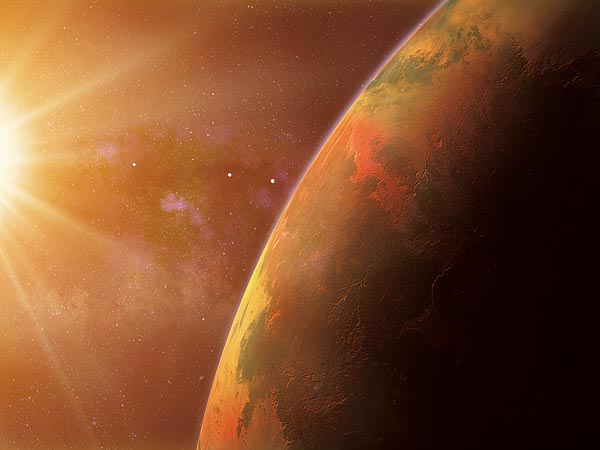Think Outside the Box to Find Extraterrestrial Life
Our Milky Way galaxy, and the billions of others beyond, is chock-a-block with extra-solar planets, scientists have learned in recent decades. But whether any of them can support life is a far more complex and contentious issue.
Many researchers hold that potentially "habitable" planets have to be rocky and within a limited zone in relation to their central sun—conditions that allow for the continuing presence of liquid water on their surfaces.
But in a provocative review article published this week in the journal Science, theoretical physicist Sara Seager of the Massachusetts Institute of Technology lays out a case for habitability being potentially more common than generally predicted.
As a pioneer in the study of exoplanet atmospheres, she paints a different picture of what kinds of planets might support life.
"Our basic premise is that to be habitable, a planet has to have liquid water," Seager said in an interview. "In addition, planets with thin atmospheres are mostly heated by their stars."
"But what primarily controls surface temperature is the greenhouse effect, what types of gases are in the atmosphere, and how massive a planet's atmosphere is. That's what we really have to understand."
An illustration of the four planets in the Gliese system, a distant planetary system that may hold signs of life.
Not Your Usual Planet
With that in mind, Seager describes how large planets ten times farther from their stars than Earth is from the sun could also have liquid water and potentially life if, for instance, they had enough hydrogen gas in their atmospheres.
Hydrogen gas, she said, has a much more powerful greenhouse effect than what's in our atmosphere. So it could potentially keep a planet's surface warm with far less radiation from its star.
Relatively dry planets that are close to their suns could also be habitable, Seager said. They need to have less water to create suitable temperatures at their surface because atmospheric moisture is the most effective greenhouse gas of all.
She described Venus as an example of the dynamic run amok: The close-in planet once had a lot of water, but the presence of so much moisture set off a runaway greenhouse effect that ultimately made the planet unlivable. A drier early Venus, she said, might have evolved into a quite habitable planet.
Planets that aren't even orbiting stars—the many free-floating planets now known to exist—could support life, she said. They would need heat generated by radioactive or other processes at their cores, as well as the necessary atmospheric gases to keep the warmth in the atmosphere.
"If there is one important lesson from exoplanets," Seager writes in her Science review, "it is that anything is possible within the laws of physics and chemistry."
Astronomers have been extraordinarily successful in finding exoplanets in recent years, and have been finding many within what are considered to be classic habitable zones.
Signs of Life
The next step for the researchers is to learn how to identify elements and compounds in the atmospheres that are considered "biosignature gases," or signs of possible life. This is Seager's specialty.
On Earth, for instance, the presence of large amounts of atmospheric oxygen is a sure sign of life because it would quickly bond with other elements and disappear if not constantly replenished.
In exoplanet atmospheres other compounds, like ozone and methane, especially in conjunction with oxygen, would be considered signs of possible extraterrestrial life.
James Kasting, an exoplanet expert from Pennsylvania State University, said that Seager's views on the potential diversity of habitable exoplanets are similar to those held by others in the community. But her emphasis on these planets as targets for future exploration is something of a challenge.
That's not because of the science involved, but because of long-planned and long-frustrated efforts to have NASA launch an orbiting telescope that could actually image and analyze exoplanet atmospheres.
Eye in the Sky
A past effort to get such an instrument off the ground—called the Terrestrial Planet Finder (TPF)—is extremely unlikely to be funded anytime soon because of its $5 billion-plus price tag.
"The telescope we hope someday will be built has to be designed to look for particular kinds of planets," Kasting said. "Many of us believe a TPF telescope that looks at planets in more conservatively defined habitable zones is more likely to be successful than those that look for these hydrogen exoplanets or others outside of our best understood areas."
While a TPF mission is well off in the future, NASA recently approved development of another exoplanet-finding satellite called the Transiting Exoplanet Survey Satellite (TESS).
Scheduled to launch in 2017, TESS will look for exoplanets around 500,000 of the smaller, cooler class M stars that are relatively close to our solar system. In contrast, the Kepler Space Telescope searches for exoplanets in a distant region containing 150,000 stars hundreds of light-years away.
TESS will not be capable of providing significant information about exoplanet atmospheres on its own, but it may be able to do so in conjunction with the James Webb Space Telescope "if we're lucky," Seager said. The James Webb Space Telescope is scheduled to go up in 2018.
Seager concludes her journal article by writing that despite obstacles, "the field of exoplanet characterization is on track to understand habitability and to find habitable worlds."
That doesn't mean extraterrestrial life necessarily exists, or that any possible future detection will come with 100 percent certainty, she said. But at least we're getting ever better at looking.(Marc Kaufman,for National Geographic News,Published May 2, 2013)












